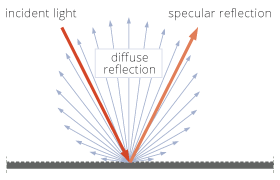Specular Gloss Test
Gloss is one of the most important characteristic for the appearance of coated metal products. It is a measurement of how the surface reflects light in the specular direction. The affecting factors to determine gloss are: refractive index of the material, the angle at which light is directed from the surface and the roughness of the surface.
The common angles of incidence for gloss measurement are:
- 20° - gloss surface
- 60° - semi-gloss surface
- 85° - matte surface
Specular reflection is defined as the amount of light reflected from a surface in an equal and opposite direction to the angle of light striking it. Diffuse reflection is defined as the amount of light that is scattered over a range of directions.

Gloss is measured using a gloss meter. The gloss meter detects the amount of reflected light at a specific angel related to the test surface and simultaneously measures the amount of light which is send to the surface. A very good article explaining the technical aspect of gloss measurement in detail can be found at: http://www.gloss-meters.com
Gloss level is declared as GU - gloss units. Usually the standard reference angle for measurement is 60°. If the amount of reflected light is below 10GU (matte surface) the measurement anlge changes to 85°. In this case the area has a larger measuring spot which adapts slightly uneven or textured surfaces.
If the amount of reflected light is above 70GU (high glossy) the measurement angle changes to 20° for a better resolution. In this case the measurement unit reacts with a higher sensitivity level to shine haze.
